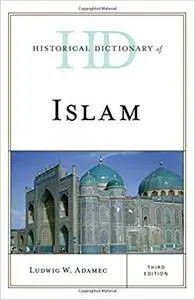Historical Dictionary of Islam, Third Edition
Rowman & Littlefield | English | 2018 | ISBN-10: 1442277238 | 656 pages | PDF | 4.60 MB
Rowman & Littlefield | English | 2018 | ISBN-10: 1442277238 | 656 pages | PDF | 4.60 MB
by Ludwig W. Adamec (Author)
Muslims believe that the Koran is God’s message in Arabic, revealed through the medium of the Prophet Muhammad for the guidance of the Arabs and subsequently for all humanity. There is both unity and variety in the Islamic world. Muslims are not a homogeneous people who can be explained solely by their normative texts: the Koran and the Sunnah. Muslims differ vastly in their interpretation of Islam: modernists want to reinterpret Islam to adapt to the requirements of modern times while traditionalists tend to look to the classical and medieval periods of Islam as their model of the Islamic state.
This third edition of Historical Dictionary of Islam contains a chronology, an introduction, appendixes, and an extensive bibliography. The dictionary section has over 700 cross-referenced entries on major sects, schools of theology, and jurisprudence, as well as aspects of Islamic culture. This book is an excellent resource for students, researchers, and anyone wanting to know more about Islam
Review
[An] authoritative reference work. . . .Adamec doesn’t shy away from the current conflict in the Islamic world between ‘literalists’ and ‘modernists’ and includes both ‘radical Islamists and their opponents’ in his sometimes brutally honest, yet fair and objective, survey. Meant to be ‘a concise dictionary of Islamic history, religion, philosophy, and political movements,’ this third edition contains many new entries and expands on existing ones. With more than 700 entries (or approximately 480 pages), this edition appears to contain approximately 40 percent more information than the last (at over 340 pages of entries). . . .Changes to the third edition include a newly updated chronology through 2015, adding major events from the last decade. Other features include an appendix containing population statistics by region and country, both in absolute numbers and as a percentage of the total population for each country and world region. . . .This edition also contains a quick-reference glossary of Islamic terms, and it closes with an extensive, updated themed bibliography listing over 125 new sources covering the major Muslim geographic areas and a variety of subtopics. These will be useful to the serious scholar. (American Reference Books Annual)
Based purely on a comparison with the book's previous editions, this edition is greatly expanded from the first and further updated from the second. If a library owns only the first, it may be worthwhile to get the new one if an up-to-the-minute treatment of some of its covered topics is required.
Summing Up: Recommended. High school through undergraduate students; general readers. (CHOICE)
About the Author
Ludwig W. Adamec is professor emeritus at the University of Arizona and served as the director of the Near Eastern Center for 10 years. He is widely known as a leading authority on Afghanistan and the author of 24 volumes and numerous articles and monographs).



